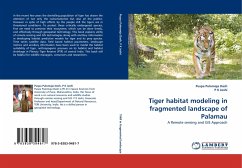In the recent few years the dwindling population of tiger has drawn the attention of not only the conservationist but also all the publics. However in spite of high efforts by the people still the tigers are in threatened conditions. To protect these critically endangered species, first we need to preserve their ecosystem, which can be done timely, cost effectively through geospatial technology. This book explains utility of remote sensing and GIS technologies along with ancillary information in developing habitat predictive models for tiger and its prey species. Time series satellite data, field based habitat parameters, landscape metrics and ancillary information have been used to model the habitat suitability of tiger, anthropogenic pressure on its habitat and habitat shrinkage in Plamau Tiger Reserve (PTR) of central India. This book will be helpful for wildlife managers, conservers and researchers.
Bitte wählen Sie Ihr Anliegen aus.
Rechnungen
Retourenschein anfordern
Bestellstatus
Storno








